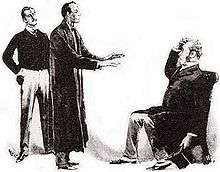The Adventure of the Beryl Coronet
| "The Adventure of the Beryl Coronet" | |
|---|---|
 Holmes, Watson and Holder, 1892 illustration by Sidney Paget | |
| Author | Arthur Conan Doyle |
| Series | The Adventures of Sherlock Holmes |
| Publication date | 1892 |
"The Adventure of the Beryl Coronet", one of the 56 short Sherlock Holmes stories written by British author Sir Arthur Conan Doyle, is the eleventh of the twelve stories collected in The Adventures of Sherlock Holmes. The story was first published in Strand Magazine in May 1892.
Plot

A banker, Mr. Alexander Holder of Streatham, makes a loan of £50,000 to a socially prominent client, who leaves a beryl coronet — one of the most valuable public possessions in existence — as collateral. Holder feels that he must not leave this rare and precious piece of jewellery in his personal safe at the bank, and so he takes it home with him to lock it up there. He is awakened in the night by a noise, enters his dressing room, and is horrified to see his son Arthur with the coronet in his hands, apparently trying to bend it. Holder's niece Mary comes at the sound of all the shouting and, seeing the damaged coronet, faints dead away. Three beryls are missing from it. In a panic, Mr. Holder travels to see Holmes, who agrees to take the case.
The case against Arthur seems rather damning, yet Holmes is not convinced of his guilt. Why is Arthur refusing to give a statement of any kind? How could Arthur have broken the coronet (even Holmes, who has exceptionally strong hands, cannot do it) and without making any noise? Could any other people in the household be involved, such as the servants, or Mary? Could some visitor, such as the maid's wooden-legged boyfriend, or Arthur's rakish friend Sir George Burnwell, have something to do with what happened to the coronet? The failure to resolve the case will result in Mr. Holder's dishonour, and a national scandal.
Holmes sets about not only reviewing the details that he learns from Holder, but also by examining the footprints in the snow outside. Eventually, Holmes solves the mystery, and Holder is flabbergasted to find that his niece was in league with a notorious criminal (Sir George Burnwell), although apparently she is unaware of his character. The two of them escape justice; however, Holmes is convinced that they will receive their punishment in due time. Arthur's motive in allowing his father to think he was the thief was that he was in love with his cousin Mary and saw her passing the coronet to a confederate outside the window. (The Coronet was broken when Arthur was struggling to wrench it from Burnwell's grasp.) Holmes regains the coronet after threatening Sir George at gunpoint.
Adaptations
The story was adapted for an episode of the 1965 television series Sherlock Holmes with Douglas Wilmer as Holmes, Nigel Stock as Watson, Leonard Sachs as Holder and Suzan Farmer as Mary. It also featured David Burke as Sir George Burnwell. Burke would later play Watson opposite Jeremy Brett in the first two seasons of The Adventures of Sherlock Holmes.
The story was used in part in the Elementary episode 'How the Sausage Is Made.'[1]
"The Beryl Coronet" was dramatised for the BBC Light Programme in 1959, and broadcast on the 30th of June as part of the Thirty Minute Theatre series (one of six such plays transmitted that year)[2], starring Carleton Hobbs as Sherlock Holmes, with Norman Shelley as Doctor Watson, Hilda Schroder as Miss Parker and Lucy Parr, Frederick Treves as Arthur Holder, Robert Sansom as Alexander Holder, Ronald Baddiley as Roberts, Godfrey Kenton as His Grace and Eva Huszar as Mary Holder. It was adapted by Michael Hardwick.[3]
Another version was made, this time for BBC Radio 4 in 1991 as part of Bert Coules' complete radio adaptation of the canon, starring Clive Merrison as Holmes and Michael Williams as Watson, and featuring Anthony Newlands as Holder, Angus Wright as Arthur, Petra Markham as Mary, and Timothy Carlton (father of Benedict Cumberbatch, another famous Sherlock) as Sir George Burnwell.[4]
'Sequel'
The novel The Further Adventures of Sherlock Holmes, The Improbable Prisoner by Stuart Douglas, is a subtle 'sequel' to this story; Mary Parr, the sister of the maid in this story, frames Watson for murder because blames him for her sister's suicide, as the maid was dismissed after the events of this case and Watson's portrayal of her in the novel affected her reputation to the point that she was unable to find work.
References
- ↑ Valentine, Genevieve. "When Joan and Sherlock fight, Elementary wins". TV Club. Retrieved 2018-05-21.
- ↑ "Sherlock Holmes (radio show 1952-1969)". The Sir Arthur Conan Doyle Encyclopedia. Retrieved 14 February 2018.
- ↑ "Sherlock Holmes". BBC iPlayer Radio. Retrieved 14 February 2018.
- ↑ Bert Coules. "The Adventures of Sherlock Holmes". The BBC complete audio Sherlock Holmes. Retrieved 12 December 2016.
External links

